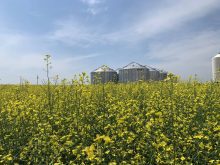Central Alberta farmer, Mike Nelson knows his canola fell short of the magic 100-bushel yield mark for the 2016 Canola 100 Challenge, but the experience made it worthwhile for him to consider the contest again.

Nelson, who is part of the family farming operation, Nelson Farms, that includes his father Lorne, brother Matt and brother-in-law Tyson Kinsey, says the prize that included the use of a fleet of new John Deere equipment is a big draw, but he also wanted to test the potential of the canola crop on his Westaskiwin-area farm.
“It is a great prize,” says Nelson. “But, I also thought it would be fun just to see what I could do with canola. We didn’t make that 100-bushel yield this year, but we did increase yield by at least 10 to 12 bushels. I would definitely be interested in doing the contest again.”
Nelson was one of about 80 some farmers from across Canada who registered for the Canola 100 challenge — a national contest sponsored by Agri-Trend Agrology, John Deere Canada and Glacier Farm Media. The contest threw down the challenge to Canadian farmers to produce a plot of canola with a verified yield of at least 100 bushels per acre. Grand prize to the first farmer to hit that yield over the three-year term of the contest is 100-hours of free use of a fleet of John Deere equipment — everything from seeding to harvest.
Read Also

Cancer agency reclassifies another herbicide ‘probably carcinogenic’
The WHO’s cancer research agency has now put atrazine, a herbicide well known to corn growers, in the same potential-hazard category where the agency put glyphosate.
Of the 80 who registered, 21 farmers actually saw the contest through to the final harvest verification stage. Farmers needed to produce a 50-acre block of canola to be harvested, and yields verified by third-party auditors. The yields from those 21 farms will be in the running for the prize in 2016. If there is no 100 bushel-yield recorded, the contest continues through the 2017 and 2018 growing seasons.
Nelson, who has been growing canola all of his farming career — about 20 some years — says he didn’t go overboard for the Canola 100 challenge, but he did apply some extra TLC to a 160 acre field well suited for the oilseed crop. He drew on advice and suggestions from agronomists at Parkland Fertilizer as well.
The process
Farming in the Black Soil zone, he treated all 160 acres the same, and then measured out a 50-acre parcel in that field to be harvested for the Challenge. The Nelson field hadn’t grown canola for at least four years. He direct seeded canola into wheat stubble in 2016. In 2014 the field had been in peas.
Treatments to the field started in the fall of 2015 with a broadcast application of 160 pounds of ammonium sulphate (sulphur fines) per acre that was later harrowed. In the spring of 2016, Nelson applied a pre-seeding weed control burn off with gylphosate, followed with seeding May 14.
For the contest, Nelson selected InVigor L241C the newest clubroot-resistant hybrid from Bayer Crop Science. Along with high yield potential and strong standability, it has a mid maturity suited for all clubroot-affected regions of Western Canada.
It was seeded at rate of five pounds per acre, with a Bourgault 3320 XTC seeding system equipped with mid-row banders. He placed 50 pounds of another predominantly sulphur product, S-15, with the seed and banded 100 pounds of actual nitrogen and another 10 pounds of sulphur in the mid-row band.
For in-crop treatments, Nelson applied herbicide, fungicides and a new top-dress nutrient product.
With the herbicide-tolerant Invigor canola he applied early and later treatments of Liberty herbicide. To control blackleg, Priaxor fungicide was included with the first herbicide application. He used field sprayer equipment to make two more fungicide treatments with another product, also during the growing season to control sclerotina. “I had actually planned on a third fungicide application for sclerotina with an aerial applicator but we couldn’t schedule the timing,” he says.
The newest element in producing canola for this challenge included three applications of a foliar nutrient product during the growing season. Nelson hadn’t used it before and the jury is still out on whether it made a difference.
“There was no obvious difference in crop treated with the foliar products, but overall yields were 10 to 12 bushels higher, but that might have been due to a good growing season and overall higher fertility,” says Nelson. “We had nearly ideal growing conditions this past summer, so I don’t know if the foliar treatments made much difference.”
After all treatments were made, the crop was later swathed at about 80 per cent seed colour change, left in the swath for about 10 days before being combined Sept. 21 and hauled to the Richardson Pioneer elevator in nearby Lacombe for weighing.
Nelson says although input costs were higher for the Canola 100 plot, he still made money due to increased yield.
“As you increase your input costs, the risk increases too,” he says. “I don’t know if I would do this over all of our canola acres. It’s great if you get the yield, but depending on the year and conditions there is no guarantee of that.
“But it is worth it to me to see what it takes to increase canola yield and perhaps one day hit that 100 bushel mark. If the contest continues I would be interested in doing it again.”
















